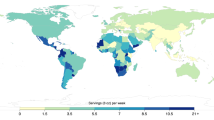Abstract
Background
Childhood obesity is associated with an increased intake of sugary soft drinks and juice drinks. The aims of this study were (1) to report the sugar and energy content in commercial fruit juice (FJ), juice drinks (JDs) and smoothies (S) specifically targeted at children in the UK, (2) to identify beverages liable for the soft drinks industry levy (SDIL) and (3) to compare the amount of sugar in these beverages before and after the levy.
Methods
The beverages were retrieved using the online shopping tool, my Supermarket, websites of nine major supermarkets in the UK and manufacturers webpages. Comparisons of sugar content were taken before and after the introduction of the SDIL.
Results
131 FJJDS fulfilled the inclusion criteria. The mean sugar content of all the beverages was 6.3 g ± 4.5/100 mL. There was large variation in the sugar content from 0.1 g/100 mL to 15.2 g/100 mL, with smoothies found to contain the most sugar (11.55 ± 1.62 g/mL). The beverages were reanalysed in September 2018 to determine their eligibility for the SDIL. Of the 131 products only seven JDs were eligible for the levy. Four of these beverages had reformulated their ingredients since the initial analysis resulting in a sugar content of <5 g/100 mL.
Conclusions
The majority of the beverages targeted at children and children’s lunch boxes were not eligible for the SDIL. This study suggests the necessity to adapt the SDIL to include all FJJDS aimed at children as the total sugar content of these beverages are still above the recommended quantities for this age group.
This is a preview of subscription content, access via your institution
Access options
Subscribe to this journal
Receive 12 print issues and online access
$259.00 per year
only $21.58 per issue
Buy this article
- Purchase on Springer Link
- Instant access to full article PDF
Prices may be subject to local taxes which are calculated during checkout
Similar content being viewed by others
References
WHO. Taking action on childhood obesity. 2018. http://apps.who.int/iris/bitstream/handle/10665/274792/WHO-NMH-PND-ECHO-18.1-eng.pdf?ua=1. Accessed Oct 2018.
Health and Social Care Information Centre. National Child Measurement Programme, England 2017/18. 2018 https://files.digital.nhs.uk/9F/22AF4D/nati-chil-meas-prog-eng-2017-2018-rep.pdf. Accessed Jan 2019.
Malik S, Pan A, Willett WHF. Sugar-sweetened beverages and weight gain in children and adults: a systematic review and meta-analysis. Am J Clin Nutr 2013;98:1084–102.
Lifshitz F. Obesity in Children. J Clin Res Pediatric Endo 2008;1:53–60.
Bes-Rastrollo M, Sayon-Orea C, Ruiz-Canela M, Martinez-Gonzalez MA. Impact of sugars and sugar taxation on body weight control: A comprehensive literature review. Obesity 2006;24:1410–26.
Sahoo K, Sahoo B, Choudhury AK, Sofi NY, Kumar R, Bhadoria AS. Childhood obesity: causes and consequences. J Fam Med Prim Care 2015;4:187–92.
Scientific Advisory Committee on Nutrition. Carbohydrates and Health. The Stationary Office. 2015.
Public Health England. Health matters: child dental health—GOV.UK. 2018. https://www.gov.uk/government/publications/health-matters-child-dental-health/health-matters-child-dental-health. Accessed Jan 2019.
British Nutrition Foundation. Perfect portions for toddler tums. 2014. https://www.nutrition.org.uk/attachments/article/734/BNF Toddler Eatwell Leaflet_OL.pdf. 2014. Accessed Feb 2019.
Public Health England. National Diet and Nutrition Survey. Results from Years 7 and 8 (combined) of the Rolling Programme (2014/2015 to 2015/2016). 2018 https://www.gov.uk/government/statistics/ndns-results-from-years-7-and-8-combined. Accessed Oct 2018.
Vieux F, Maillot M, Constant F, Drewnowski A. Water and beverage consumption patterns among 4 to 13-year-old children in the United Kingdom. BMC Public Health 2017;17:479.
HM Government. Childhood Obesity A Plan for Action. 2016. https://www.gov.uk/government/publications/childhood-obesity-a-plan-for-action/childhood-obesity-a-plan-for-action. Accessed Feb 2019.
UK Government. Soft Drinks Industry Levy comes into effect—GOV.UK. 2018. https://www.gov.uk/government/news/soft-drinks-industry-levy-comes-into-effect. Accessed Feb 2019.
HM Revenue & Customs. (2018) Check if your drink is liable for the Soft Drinks Industry Levy—GOV.UK. 2018. https://www.gov.uk/guidance/check-if-your-drink-is-liable-for-the-soft-drinks-industry-levy. Accessed Feb 2019.
Boulton J, Hashem KM, Jenner KH, Lloyd-Williams F, Bromley H, Capewell S. How much sugar is hidden in drinks marketed to children? A survey of fruit juices, juice drinks and smoothies. BMJ Open 2016;6:1–5.
British Soft Drinks Association (BSDA). Fruit Juice Technical Guidance—1st ed. 2016; (May): 1–36.
Buttris J Why 5%? An explanation of SACN’s recommendations about sugars and health Public Health England. 2015 https://www.gov.uk/government/publications/sacns-sugars-and-health-recommendations-why-5. Accessed Feb 2019.
Gill JMR, Sattar N. Fruit juice: just another sugary drink? Lancet Diabetes Endocrinol 2014;2:444–6.
Mintel Store. UK Fruit Juice, Juice Drinks and Smoothies Industry Report. 2016. https://store.mintel.com/uk-fruit-juice-juice-drinks-and-smoothies-market-report. Accessed Dec 2018.
Du M, Tugendhaft A, Erzse A, Hofman KJ. Sugar-sweetened beverage taxes: industry response and tactics. Yale J Biol Med 2018;91:185–90.
Moran AJ, Roberto CA. Health Warning Labels Correct Parents’ Misperceptions About Sugary Drink Options. Am J Prev Med 2018;55:e19–27.
Author information
Authors and Affiliations
Contributions
SEH and MEC developed the research question, BTYC and CPI collected the data. All authors contributed to the analysis of the findings of the paper and wrote the paper. All authors approved the final submission.
Corresponding author
Ethics declarations
Conflict of interest
The authors declare that they have no conflict of interest.
Additional information
Publisher’s note: Springer Nature remains neutral with regard to jurisdictional claims in published maps and institutional affiliations.
Rights and permissions
About this article
Cite this article
Chu, B.T.Y., Irigaray, C.P., Hillier, S.E. et al. The sugar content of children’s and lunchbox beverages sold in the UK before and after the soft drink industry levy. Eur J Clin Nutr 74, 598–603 (2020). https://doi.org/10.1038/s41430-019-0489-7
Received:
Revised:
Accepted:
Published:
Issue Date:
DOI: https://doi.org/10.1038/s41430-019-0489-7



